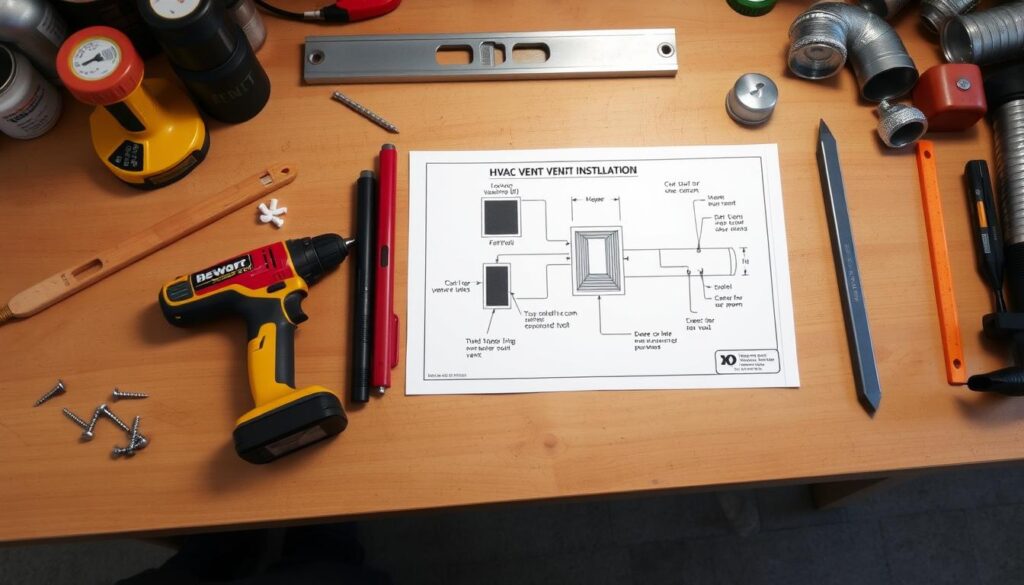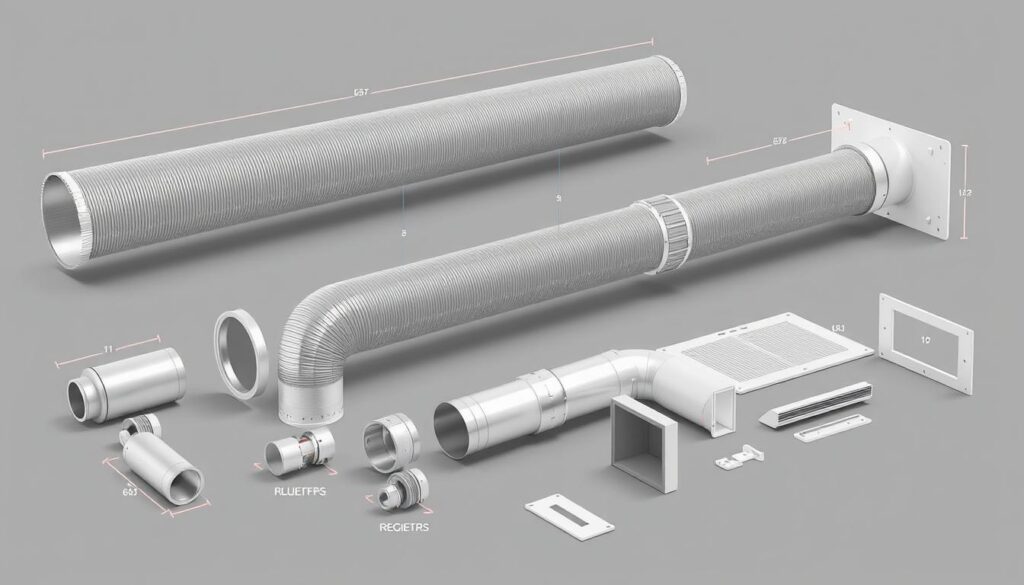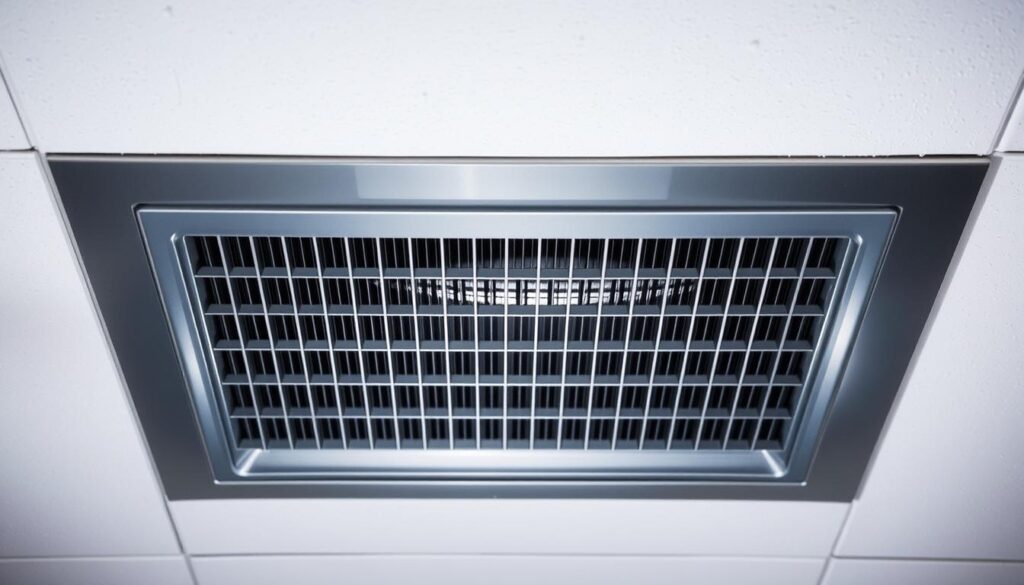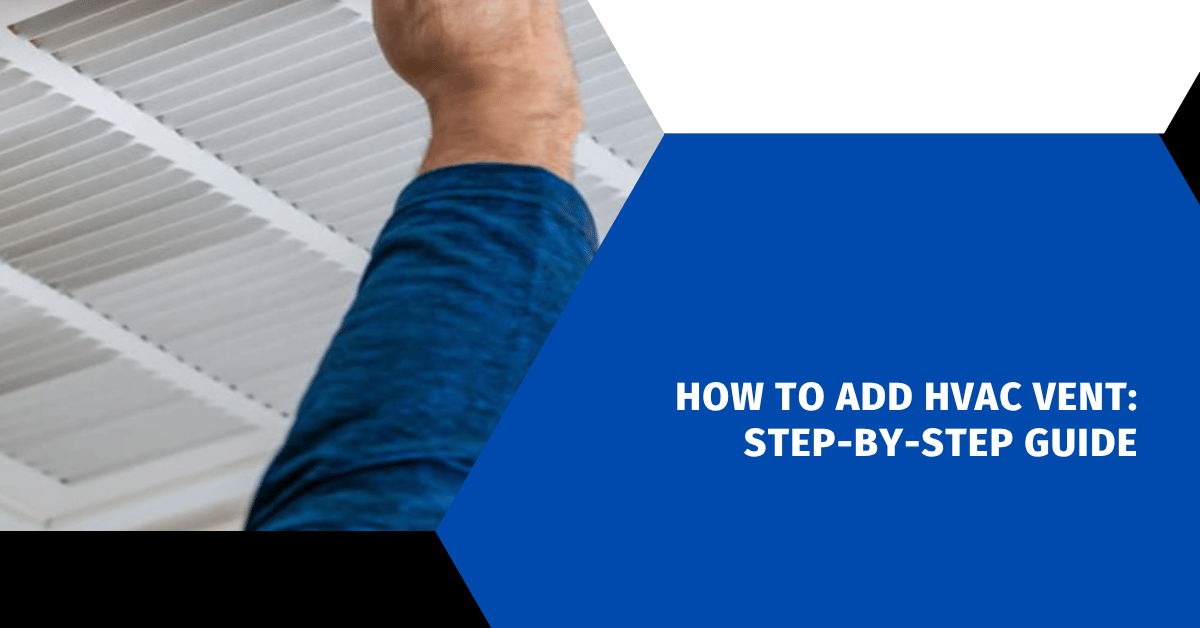Affiliate Disclosure
HVAC Guide Guys is a participant in the Amazon Services LLC Associates Program, an affiliate advertising program designed to provide a means for sites to earn advertising fees by advertising and linking to Amazon.
How to Add HVAC Vent? Are you tired of uneven temperatures and poor air circulation in your home? Learning how to add HVAC vents can greatly improve your home’s comfort and efficiency. Installing hvac ductwork is more than just a technical task. It’s a way to make your home more comfortable.

Adding HVAC vents needs careful planning and precise execution. Whether you’re updating an old home or enhancing ventilation in a new one, knowing the right methods is key. It can significantly improve your home’s air quality and temperature control.
This detailed guide will show you the important steps of HVAC vent installation. You’ll gain the knowledge and confidence to successfully complete this home improvement project.
Key Takeaways
- Learn professional techniques for HVAC vent installation
- Understand critical safety precautions during ductwork work
- Discover how proper ventilation impacts home comfort
- Identify essential tools needed for successful installation
- Recognize potential challenges in vent placement
Table of Contents
Understanding HVAC Vent Systems and Their Importance
Your home’s comfort depends on a well-designed HVAC system. It effectively manages airflow. Knowing how air circulation works helps you decide on adding return air vents and new air supply vents.
HVAC systems have two key parts: supply and return air ducts. These pathways work together. They keep indoor air quality and temperature just right.
Types of Air Ducts: Supply and Return
Air ducts are mainly two types:
- Supply Ducts: Push conditioned air into living spaces
- Return Ducts: Collect used air and send it back to the air handler
Benefits of Proper Ventilation
Proper ventilation brings many benefits to homeowners:
- Improved indoor air quality
- Enhanced energy efficiency
- Consistent temperature distribution
- Reduced humidity levels
Basic Airflow Principles
Effective airflow needs balanced pressure and smart vent placement. When adding return air vents or new air supply vents, keep these principles in mind:
| Airflow Principle | Impact on HVAC Performance |
|---|---|
| Pressure Equilibrium | Ensures smooth air circulation |
| Vent Positioning | Maximizes air distribution efficiency |
| Proper Sizing | Prevents system strain and maintains performance |
Understanding these basics helps optimize your home’s ventilation. It makes your living space more comfortable.
Explore Our HVAC Shop
Looking for top-rated HVAC tools, parts, and accessories? Visit our shop and find the perfect solution for your needs.
Visit the ShopEssential Tools and Materials for HVAC Vent Installation
Installing HVAC vents needs careful planning and the right tools. It’s important to pick the right hvac vent types and covers for a good job. Both pros and DIY folks need a full toolkit for safe and efficient setup.
- Measuring tools:
- Tape measure
- Laser level
- Marking pencil
- Cutting equipment:
- Utility knife
- Sheet metal cutters
- Reciprocating saw
- Fastening materials:
- Metal clamps
- Duct tape
- Self-tapping screws
Choosing hvac vent covers depends on room size, airflow needs, and looks. There are many hvac vent types, like wall or ceiling vents, for different setups.
Always wear safety gear while installing. This includes:
- Safety glasses
- Work gloves
- Dust mask
- Steel-toed boots
Your list should have flexible ductwork, metal ducts, insulation, and sealants. Quality materials help avoid problems later and keep your system running well.
Planning Your Vent Location and Layout
Creating a good HVAC vent system needs careful planning. Where you place vents affects your home’s heating and cooling. It’s all about comfort and saving energy.
Determining Optimal Vent Placement
When picking where to put vents, several things matter. You should think about:
- Room size and how big it is
- What your home’s layout is like
- How air moves around
- Where your furniture and decor are
Measuring and Marking Installation Points
Getting the right size for vents is key for good air flow. Here’s how to measure right:
- Measure your room’s size carefully
- Figure out how big your vent should be based on room size
- Use painter’s tape to mark where vents might go
- Make sure vents won’t hit walls or furniture
Considering Building Codes and Regulations
Before you start, check local rules for HVAC systems. Each area has its own rules for vents. Getting help from a pro can make sure you follow these rules.
Pro Tip: Always prioritize proper ventilation and airflow when planning your HVAC vent layout.
Good vent placement is about being precise and practical. Spend time planning well to make your home’s cooling and heating system work great.
Explore Our HVAC Shop
Looking for top-rated HVAC tools, parts, and accessories? Visit our shop and find the perfect solution for your needs.
Visit the ShopHow to Add HVAC Vent: Preparation Steps
Getting ready for HVAC ductwork installation is all about planning and detail. Before you start adding an HVAC vent, you need to do some important steps. These steps will help make the installation process smooth and efficient.
First, collect all the tools and safety gear you’ll need. Your kit should have:
- Protective safety glasses
- Work gloves
- Dust mask
- Measuring tape
- Flashlight
- Electrical circuit tester
When adding an HVAC vent, safety is key. Always switch off the electrical power to your HVAC system at the circuit breaker before starting. This step keeps you safe from electrical accidents and power surges.
Then, check your current ductwork for damage, debris, or blockages. These could get in the way of your new vent. Clear the area well, moving furniture and making sure you have enough room to work.
Good preparation is crucial for a successful HVAC ductwork installation. Take your time, be thorough, and always put safety first.
Creating and Cutting Vent Openings
Learning how to add HVAC vent starts with knowing how to make openings. This process needs careful planning, special tools, and focus on details. It’s all about getting the right size for your vents and ensuring good airflow.
When cutting vent openings, you must be precise and safe. First, get the right tools and protect your area and yourself.
Essential Cutting Tools
- Reciprocating saw
- Drywall saw
- Measuring tape
- Stud finder
- Protective safety glasses
- Dust mask
Safety Precautions During Cutting
Always put safety first when making HVAC vent openings. Wear protective gear and follow these important steps:
- Find electrical wiring and plumbing before you start
- Use a stud finder to find wall studs
- Mark your cutting spots carefully
- Wear safety glasses and a dust mask
Proper Hole Sizing Guidelines
Getting the right size for your vents is key for good airflow. Here are some size guidelines:
| Room Size | Recommended Vent Size |
|---|---|
| Small Room (up to 100 sq ft) | 6″ x 10″ |
| Medium Room (100-250 sq ft) | 8″ x 14″ |
| Large Room (250-400 sq ft) | 10″ x 16″ |
Remember, measure twice and cut once. Make sure your cuts are clean and exact. This helps with proper vent installation and keeps your system running well.
Explore Our HVAC Shop
Looking for top-rated HVAC tools, parts, and accessories? Visit our shop and find the perfect solution for your needs.
Visit the ShopInstalling Flexible Ductwork Components

Flexible ductwork is key for efficient HVAC systems. It’s great for making new air supply vents in homes and businesses.
When picking flexible ducts for your HVAC, you’ll find two main types:
- Insulated polyester flexible duct: Perfect for areas where temperature matters
- Foil flexible duct: Great for tight or hard-to-reach spots
Installing flexible ductwork needs careful steps:
- Measure the duct length accurately
- Choose the right flexible duct material
- Cut the duct with sharp tools
- Connect it right to the existing ductwork
| Duct Type | Best Application | Temperature Resistance |
|---|---|---|
| Polyester Flexible Duct | Residential HVAC | -20°F to 200°F |
| Foil Flexible Duct | Commercial Spaces | -40°F to 250°F |
When installing new air supply vents, support and fastening are crucial. Use metal clamps and avoid bending to keep airflow and efficiency high.
Connecting and Securing Vent Components
Connecting HVAC vent parts right is key for a good ventilation system. You need to pay close attention to details. This ensures your hvac vent grilles and covers work well.
When you connect your ductwork, focus on a few important things. These steps help make your installation secure and effective.
Sealing Techniques for Optimal Performance
Sealing well stops air leaks and keeps your system running smoothly. Use these methods:
- Apply mastic sealant around all duct connections
- Use foil tape made for HVAC
- Make sure connections between vent parts are tight and without gaps
Metal Clamps and Fastener Installation
Strong connections are vital for your HVAC system’s health. Here’s how to use metal clamps:
| Clamp Type | Recommended Use | Spacing Guidelines |
|---|---|---|
| Adjustable Steel Clamps | Flex Duct Connections | Every 4-6 feet |
| Sheet Metal Screws | Rigid Duct Connections | 6-inch intervals |
Insulation Requirements
Insulating your hvac vent covers well boosts energy efficiency. Wrap flex ducts with insulation made for your climate zone. This step cuts down on heat loss and energy use.
By using these connection and securing methods, you’ll have a strong HVAC system. It will give you steady, efficient airflow in your space.
Testing Airflow and System Performance

After you’ve done your hvac vent maintenance, it’s time to test the system. You need to make sure your vents are working right and bringing in good airflow. This is important for your home’s comfort.
Begin by checking the airflow in your home. You want to see that cool air moves well and evenly to all rooms. Knowing how to test your hvac system is key to keeping it running well.
- Check air temperature at different registers
- Measure airflow volume using an anemometer
- Listen for unusual sounds during operation
- Inspect for any air leaks around vent connections
Experts say to use digital tools for airflow tests. These tools show if there are blockages or problems in your system.
Watch out for issues like:
- Uneven cooling between rooms
- Reduced air pressure in specific areas
- Unexpected temperature variations
Testing your HVAC system often keeps it running smoothly. It also stops big problems from happening. By doing these tests, you make sure your vents help keep your home comfortable and the air clean.
Explore Our HVAC Shop
Looking for top-rated HVAC tools, parts, and accessories? Visit our shop and find the perfect solution for your needs.
Visit the ShopCommon Installation Mistakes to Avoid
When installing hvac ductwork, homeowners often make critical mistakes. These errors can hurt system efficiency and performance. Knowing these common mistakes can save you from costly repairs and ensure your home stays comfortable.
- Incorrect Vent Sizing: Choosing the wrong duct dimensions disrupts airflow and reduces overall HVAC system effectiveness
- Poor Sealing Techniques: Inadequate duct sealing leads to air leakage, increasing energy consumption
- Improper Vent Placement: Poorly positioned vents create uneven temperature distribution
Proper hvac vent maintenance requires careful attention to detail. Experts say to avoid these critical errors during installation:
| Mistake | Potential Consequences |
|---|---|
| Inadequate Support | Sagging ductwork reduces airflow efficiency |
| Ignoring Building Codes | Potential safety violations and system failure |
| Neglecting Insulation | Energy loss and reduced system performance |
To prevent these issues, always consult professional guidelines or hire experienced HVAC technicians. Precision matters more than speed when installing ventilation systems.
Professional tip: Invest time in planning and measuring to guarantee a successful HVAC vent installation.
Conclusion
Adding an HVAC vent can make your home more comfortable and well-ventilated. This guide has shown you how to install an HVAC vent successfully. You’ve learned about airflow, choosing the right tools, and techniques for a good ventilation system.
When working on your home, safety and precision are crucial. This guide has given you detailed instructions. But, remember, HVAC vent maintenance is an ongoing task. Regular checks and cleanings can avoid problems and keep your system running well.
If you face tough challenges, don’t hesitate to ask a professional HVAC technician for help. They can offer valuable advice and support.
For a successful vent installation, planning, careful work, and attention to detail are essential. Your new HVAC vent will improve air quality, energy use, and comfort at home. By following this guide, you’re making your living space more comfortable and well-ventilated.
Your success in adding and maintaining your HVAC system depends on preparation, understanding technical needs, and knowing when to ask for help. With patience and the right steps, you can achieve great results.

